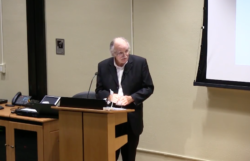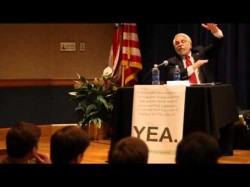The Unfinished Business of the Obama Administration: The Foreclosure Crisis
Administrations are invariably criticized for things they do right, for things they do wrong, and for things they fail to do at all. They are invariably criticized for doing too much and criticized for doing too little. Conservative critics of the current Administration tend to do the former. Liberal, by contrast, would do well to focus on the latter. For thus far, this Administration’s failures – in domestic policy at least – are more the product of doing too little too late, than of doing too much too soon. Nowhere is that failure clearer than in the Administration’s inept handling of the home foreclosure crisis.[1]
The Obama Administration did not invent or create the foreclosure crisis. It inherited it, just as it inherited a major financial crisis and a looming recession. But unlike the financial meltdown, the home foreclosure problem inherited by the Obama Administration was in its infancy as the new president took office. The housing crisis then played itself out predominantly on Obama’s own watch; with the numbers of foreclosures soaring as they did only because the Administration failed to act with a speed and an effectiveness appropriate to the occasion. It is a failure that may yet bring a heavy electoral price.
Hampered initially by moral hazard concerns – reluctant, that is, to do more than marginally bail-out homeowners who had foolishly borrowed more than they could ever hope to repay – the incoming Obama Administration failed to reset and rescale its help to struggling homeowners when the causes of the foreclosure crisis changed. But they did change – and change rapidly.[2] The foreclosure crisis was initially fueled by a fusion of reckless borrowing and reckless lending practices – a recklessness on the lending side of the equation, it should be said, that went largely unpunished, and which did not prevent a massive bail-out of the reckless in the financial community. But the crisis was then prolonged by the overall economic legacy of that financial recklessness: namely generalized recession and the involuntary unemployment of millions of Americans. People began to lose their homes not because they had over-committed themselves. They began to lose their homes because they began to lose their jobs.
Instead of then disciplining the major lenders into ending the foreclosure crisis they had both directly and indirectly triggered – instead, that is, of having major financial institutions absorb mortgage losses and allow struggling homeowners to remain (at least as renters) in their homes – the Administration focused instead on bailing-out the banks, allowing them in the process to both tighten their lending requirements on new borrowers and purge their existing portfolios of mortgages whose payments were in default. All that the Administration then offered to those on the bitter receiving end of all this new financial rigor were a series of modest initiatives to help home-owners restructure their mortgage debt, initiatives whose complexity slowed their implementation and whose modesty left millions of mortgage payers without adequate support.[3] The Banks were saved. Homeowners were not. The banking crisis is behind us. Foreclosures are still very much the order of the day.
Indeed, the number of foreclosures in 2012 is projected to be higher than it was in 2011, higher even than it was in 2010, higher than in 2009. 2010 was the terrible year, with 3.8 million “foreclosure filings – default notices, scheduled auctions and bank repossessions – reported on a record 2.8 million U.S. properties …an increase of nearly 2 percent from 2009 and an increase of 23 percent from 2008.”[4] 2011 was better. The robo-signing scandal slowed down the rate of bank foreclosures, so that overall foreclosure filings that year were 34 percent down: 2.7 million foreclosure filings on 1.9 million properties.[5] But 2012 will be worse, and possibly much worse, as banks empowered by their settlement with the states’ attornies-general clear their backlog of mortgages in default.[6] “The damn will not burst in the next 30 to 45 days,” the RealtyTrac CEO said in April, “but it will eventually burst:”[7] and when it does, we can expect an additional 5 million foreclosures by 2015, to add to the 3.8 million homes foreclosed since the financial crisis began in September 2008.[8]
These will be foreclosures that are both geographically and socially concentrated, hitting states and groups vital to Obama’s re-election chances in November. The roll-call of states in foreclosure crisis reads like an election map of battleground states: California, Nevada, Arizona, Florida, New Jersey and Illinois.[9] The roll-call of victims is equally electorally significant. The majority of people affected by foreclosure have been white, but borrowers of color are still “more than twice as likely to lose their home as white households.”[10] The wealth gap between whites, blacks and Hispanics is currently at record highs – currently “the median wealth of white households is 20 times that of black households and 18 times that of Hispanic households, according to a Pew Research Center analysis of newly available government data from 2009”[11] – and central to that gap has been the destruction of Black and Hispanic personal wealth in the housing collapse of the foreclosure crisis.[12] Right now, “approximately one quarter of all Latino and African-American borrowers have lost their home to foreclosure or are seriously delinquent, compared to just under 12 percent for white borrowers.”[13] The President will need every Latino and African-American vote he can get in November, and he will need the electoral votes of the majority of the states most adversely affected by foreclosures. Time is running out for a policy shift to bring those votes home.
—
The personal suffering involved in this foreclosure crisis is enormous, and should be our prime concern. But so too should be our sense of political frustration at the persistence and depth of the crisis itself.
Just compare the largesse with which financial institutions were bailed out in 2009 with the parsimony of the assistance then extended to their victims.[14] Compare too the alacrity with which financial institutions accepted and absorbed tax-payer assistance in their moment of need, with their subsequent slowness to extend financial help to the home-owners they finance.
- There are countless reports still available to us in the quality press of bureaucratic inertia by the banks, even after the financial settlement they made to avoid criminal liability for robo-signing errors.[15]
- There are reports of banks now setting so tough a set of mortgage requirements that entirely legitimate first-time buyers cannot enter the housing market.[16]
- There are reports of bank charges on mortgages being so high that even hard-working Americans making regular payments are seeing their mortgage debt shrink only by a fraction, with the banks swallowing the bulk of that payment in interest charges.[17]
- There are reports of a new emerging drag on the U.S. housing market – REO’s, real-estate-owned properties – houses held by banks and other lenders often standing vacant and neglected while the number of the homeless continues to grow.[18]
- There are reports of appalling slow and (in percentage terms) small distributions of promised aid by government agencies themselves,[19] and of state governments swallowing into their general revenue streams funds deliberately set aside for mortgage relief.[20]
- There are even reports of major financial wrongdoers like AIG refusing to implement their part of government programs aimed at helping mortgage owners in distress,[21] and of banks directly benefiting, on their bottom line, from programs designed to move mortgage assistance through them to home-owners under water.[22]
Given the scale of the problem, the numbers cited for success are truly depressing: probably only 800,000 families out of a potential three million helped by the flagship HAMP program,[23] or 31,000 out of a possible 458,000 for the far more modest “Hardest Hit Fund.”[24] This cannot be enough.[25]
It is true that modest proposals for further mortgage relief are slowly working their way through Congress,[26] and that there are signs of the national housing market bottoming out, perhaps even beginning a very slow return to rising prices again.[27] But that can be no comfort to the millions of Americans who have, or will, lose their homes while that housing market sputters back into life. Home-ownership became central to the American Dream for the majority of the middle class in the half-century that followed World War II. That dream is now a hollow one for more and more members of that class. The rate of home-ownership is currently at a 15 year low.[28] The cost of renting property in areas heavily hit by home foreclosures is on the rise.[29] The number of Americans getting by and sharing accommodation is now increasing.[30] The federal funds for social housing are being slashed by a Republican-dominated Congress.[31] Obama the candidate has now tilted left on his immigration policy, promising things he has so far failed to deliver. It is surely time to tilt left on housing policy also – offering real and tangible relief to a key potential electoral constituency. Eleventh hour conversions invariably come late, and have credibility problems; but better an eleventh hour conversion to radicalism than no conversion at all.
Come on, Mr. President. Give us something to campaign on. Abraham Lincoln won in 1860 on the slogan “vote yourself a farm, vote yourself a tariff.” How about this time “vote yourself a home, vote yourself a job”? After all, we desperately need them both.
[1] For an earlier report, see https://www.davidcoates.net/2012/03/26/the-white-house-and-your-house-policy-inertia-and-organizational-resistance-in-the-on-going-crisis-of-american-housing/
[2] For details, see David Coates, Answering Back: Liberal Responses to Conservative Arguments, New York: Continuum Books, 2010, pp. 230-72; and David Coates, Making the Progressive Case: Towards a Stronger U.S. Economy, New York: Continuum Books, 2011, pp. 160-78
[3] For details of the latest Administration initiatives, see Zachary A. Goldfarb and David Nakamura, “Obama announces new housing finance plan,” The Washington Post, February 1, 2012: available at http://www.washingtonpost.com/business/economy/obama-to-announce-new-housing-refinance-plan/2012/02/01/gIQAw8YghQ_story.html
[4] RealtyTrac, Record 2.9 Million U.S. Properties Receive Foreclosure Failings in 2010 Despite 30-Month Low in December, posted January 12, 2011: available at http://www.realtytrac.com/content/press-releases/record-29-million-us-properties-receive-foreclosure-filings-in-2010-despite-30-month-low-in-december-6309
[5] RealtyTrac, 2011 Year-End Foreclosure Report: Foreclosures on the Retreat, posted January 9, 2012: available at http://www.realtytrac.com/content/foreclosure-market-report/2011-year-end-foreclosure-market-report-6984
[6] See Nick Carey, Americans brace for next foreclosure wave, posted April 4, 2012: available at http://www.reuters.com/article/2012/04/04/us-foreclosure-idUSBRE83319E20120404
[7] Quoted in Brady Dennis, “Foreclosures reach lowest quarterly level since late 2007, RealtyTrac data show,” The Washington Post, April 12, 2012: available at http://www.washingtonpost.com/business/economy/foreclosures-reach-lowest-quarterly-level-since-late-2007-realtytrac-data-show/2012/04/11/gIQAjTqoBT_story.html
[8] Editorial, “Still Depressed, After All These Years,” The New York Times, June 23, 2012: available at http://www.nytimes.com/2012/06/24/opinion/sunday/housing-still-depressed-after-all-these-years.html
[9] See Nick Timiraos, “Foreclosures Show No Sign of Decline,” The Wall Street Journal, May 16, 2012: available at http://online.wsj.com/article/SB10001424052702303448404577407982615943616.html
[10] Center for Responsible Lending, Lost Ground 2011: Disparities in Mortgage Lending, and Foreclosures, North Carolina, UNC Chapel Hill, 2011, p. 3: available at http://www.responsiblelending.org/media-center/press-releases/archives/Lost-Ground-CRL-Research-Shows-Foreclosure-Crisis-Not-Halfway.html
[11] Paul Taylor et al, Twenty-to-One: Wealth Gap Rise to Record Highs Between Whites, Blacks and Hispanics, Washington DC, Pew Research Center, July 2011, p.1: available at http://www.pewsocialtrends.org/2011/07/26/wealth-gaps-rise-to-record-highs-between-whites-blacks-hispanics/
[12] Ylan Q. Mui, “For black Americans, financial damage from subprime implosion is likely to last,” The Washington Post, July 8, 2012: available at http://www.washingtonpost.com/business/economy/for-black-americans-financial-damage-from-subprime-implosion-is-likely-to-last/2012/07/08/gJQAwNmzWW_story.html
[13] Center for Responsible Lending, op.cit,, p. 4. 11 percent of African-American home-owners were in or facing foreclosure in 2011, as against 7 percent of white home-owners. Data available at http://www.responsiblelending.org/media-center/press-releases/archives/Lost-Ground-CRL-Research-Shows-Foreclosure-Crisis-Not-Halfway.html
[14] On the double standard, see Bruce Judson, Why Inequality Matters: The Housing Crisis, Our System of Justice and Capitalism, posted on The Huffington Post, February 20, 2012: available at http://www.huffingtonpost.com/bruce-judson/why-inequality-matters-th_b_1288132.html
[15] See for example Nick Timiraos and Ruth Simon, “Borrowers Face Big Delays in Refinancing Mortgages,” The Wall Street Journal, May 9, 2012: available at http://online.wsj.com/article/SB10001424052702303459004577364102737025584.html
[16] Shahien Nasiripour and Tom Braithwaite, ‘Low rates not reaching many US homeowners,” The Financial Times, June 21, 2012: available at http://www.ft.com/intl/cms/s/0/78eb14f2-baf6-11e1-81e0-00144feabdc0.html#a
[17] See Van Jones, Hope for Homeowners, posted on The Huffington Post, July 2, 2012: available at http://www.huffingtonpost.com/van-jones/hope-for-homeowners_b_1643277.html
[18] Anne O’Shaughnessy, Battling the Next Stage of the Housing Crisis, posted on Forefront, October 6, 2010: available at http://www.clevelandfed.org/forefront/2010/09/ff_2010_fall_04.cfm
[19] Annie Lowrey, ‘Treasury Faulted in Effort to Relieve Homeowners,” The New York Times, April 12, 2012: available at http://www.nytimes.com/2012/04/12/business/economy/treasury-department-faulted-in-effort-to-relieve-homeowners.html
[20] Shaila Dewan, “Needy States Use Housing Aid Cash to Plug Budgets,” The New York Times, May 15, 2012: available at http://www.nytimes.com/2012/05/16/business/states-diverting-mortgage-settlement-money-to-other-uses.html?pagewanted=all
[21] Ajay Makan and Shahien Nasiripour, “AIG frustrates mortgage refinancing plan,” The Financial Times, July 5, 2012: available at http://www.ft.com/intl/cms/s/0/0f6bffe4-c5f7-11e1-b57e-00144feabdc0.html#axzz203ukGfkr
[22] Christian Berthelsen and Alan Zibel, “Homeowner Aid Boosts Big Banks,” The Wall Street Journal, June 17, 2012: available at http://online.wsj.com/article/SB10001424052702303410404577469050569661724.html
[23] Alan Zibel, “Obama Loan Mods Still Growing, But at Snail’s Pace,” The Wall Street Journal, May 4, 2012: available at http://blogs.wsj.com/developments/2012/05/04/obama-loan-mods-still-growing-but-at-snails-pace/
[24] Shahien Nasiripour, ‘’White House criticized for home loan failings,” The Financial Times, April 12, 2012: available at http://www.ft.com/intl/cms/s/0/e479a314-841e-11e1-9d54-00144feab49a.html#axzz203ukGfkr
[25] And it isn’t. See Mike Lux, Homes, Banks and Politics: Round 2 of Settlement Talks, posted on The Huffington Post, April 7, 2012: available at http://www.huffingtonpost.com/mike-lux/obama-housing-_b_1408851.html
[26] Vicki Needham, “Push intensifies to pass home-loan refinancing bill,” The Hill, May 24, 2012: available at http://thehill.com/blogs/on-the-money/1091-housing/229451-push-intensifies-on-home-loan-refinancing-bill
[27] Binyamin Appelbaum, ‘After Years of False Hopes, Signs of a Turn in Housing,” The New York Times, June 27, 2012: available at http://www.nytimes.com/2012/06/28/business/economy/new-indications-housing-recovery-is-under-way.html
[28] Alan Zibel and Nick Timiraos, ‘Homeownership Rate Declines to 15-Year Low,” The Wall Street Journal, April 30, 2012: available at http://online.wsj.com/article/SB10001424052702303916904577376030212625796.html
[29] Shannon Bond and Anjli Raval, ‘Rental demand fuels US property market,” The Financial Times, May 21, 2012: available at http://www.ft.com/intl/cms/s/0/ae4c8274-a35a-11e1-ab98-00144feabdc0.html#axzz203ukGfkr
[30] Michael A. Fletcher, “Census bureau: Millions more Americans shared homes in face of recession,” The Washington Post, June 20, 2012: available at http://www.washingtonpost.com/business/economy/census-bureau-millions-more-americans-shared-households-in-face-of-recession/2012/06/20/gJQAaj3HrV_story.html
[31] Paul Boden, Fed Up With Housing Policy, posted on The Huffington Post, April 13, 2012: available at http://www.huffingtonpost.com/paul-boden/fed-up-with-housing-polic_b_1421394.html
Tags: AIG, American Dream, bank reform, black wealth, foreclosures, HAMP, housing crisis, mortgages, Obama administration, renting
David Coates holds the Worrell Chair in Anglo-American Studies at Wake Forest University. He is the author of Answering Back: Liberal Responses to Conservative Arguments, New York: Continuum Books, 2010.
He writes here in a personal capacity.






David Coates: The Unfinished Business of the Obama … | House Foreclosure Help says:
[…] homeowners when the causes of the foreclosure crisis changed. … Read the original: David Coates: The Unfinished Business of the Obama … ← Obama – War on the Home Front | Mortgage Loan Investigations Uncertainty Still […]
David Coates: A Tale of Two Conventions says:
[…] [27] http://www.davidcoates.net/2012/07/10/the-unfinished-business-of-the-obama-administration-the-forecl… […]
A Tale of Two Conventions « Back on the Block says:
[…] a mixture of some things done well and many things done badly: particularly things done badly on home foreclosures, and on poverty programs. But however unsatisfactory the Obama first-term ledger may look when […]